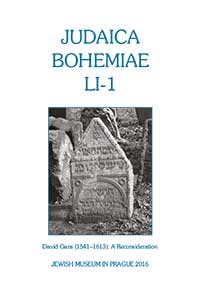TYPOGRAPHY AND PRACTICES OF READING: THE LESSON OF TZEMAH DAVID (1592)
TYPOGRAPHY AND PRACTICES OF READING: THE LESSON OF TZEMAH DAVID (1592)
INTRODUCTION: PRAGUE JEWISH PRINTERS IN THE LATE SIXTEENTH CENTURY
Author(s): Pavel SládekSubject(s): History, Jewish studies
Published by: Židovské Muzeum v Praze
Keywords: Books in Hebrew characters;Jews in Bohemia;lack of active censorship of Jewish books;the history of Hebrew printing in Prague
Summary/Abstract: Books in Hebrew characters were printed in Prague from the beginning of the second decade of the 16th century. Unlike in Italy, from where the craft of printing in Hebrew characters was imported, the Jews in Bohemia were allowed to get directly involved in the printing business, which is why the Prague and later Prossnitz (Prostìjov) presses were run directly by Jewish entrepreneurs, and not by Christian patrons and entrepreneurs as was the case with Bomberg, Giustiniani, Bragadini, the Zanettis, di Gara and others. Another striking difference was the lack of active censorship of Jewish books in the long period between 1562 and 1626. In the earliest period, the Hebrew printing press was managed by consortia of financiers and printers (1512–1522). In 1514, Seder zemirot u-virkat ha-mazon was published by one such consortium, including Gershom ben Salomon Katz who started to aspire to monopolize the business around 1525. On 10 April 1527, Gershomobtained an exclusive privilege to printHebrewbooks in Bohemia fromKing Ferdinand. Four generations of the Gersonite family (mishpahat ha-Gershuni) held the monopoly until the end of the sixteenth century. In the context of the history of Hebrew printing in Prague, the publication of Tzemah David belonged to a relatively short but important period of genre diversification that corresponded to the inclusion of Jewish Prague among the leading intellectual centers of the period. Thus the production of the Prague Jewish printing presses from 1569 until 1629 featured not only books on everyday piety and ritual, such as liturgy, Bibles, household halakhic manuals and popular ethics, as well as advanced works of exegesis, Jewish philosophy and natural science, theology, homiletics, and the Kabbalah. The beginning of this period was marked by the publication of Moses Isserles’s Torat ha-olah, probably the most important theological work of Ashkenazi provenance authored in sixteenth century. Its apex is delimited by such publications as the works of the Maharal, starting with his super-commentary on Rashi Gur aryeh (1578), Yom-Tov Lipmann Heller’s Mishnah commentary Tosafot Yom-Tov (1614–1618), or Salomon Luria’s Yam shel-Shelomo on Bava kama (1615). In 1629, a ban on the printing of Hebrew books came into effect in Prague, which marked a watershed in the history of Jewish printing there and ended a period of relative prosperity.
Journal: Judaica Bohemiae
- Issue Year: LI/2016
- Issue No: 1
- Page Range: 65-95
- Page Count: 32
- Language: English, Hebrew
- Content File-PDF

